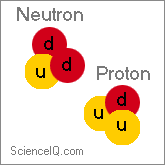Quarks
 Quarks are the most fundamental particles that we know of. Both protons and neutrons are made of quarks. We know quarks exist; we have experimental proof. However nobody has been able to isolate them; they are always found bound in groups of two or three, like those in protons or neutrons. There are six different types of quarks (physicists call them 'flavors'), each with a unique mass. The two lightest, unimaginatively called the Up and Down quarks, combine to form protons and neutrons as shown in the image. The heavier quarks aren't found in nature and have so far only been observed in particle accelerators; these are: the Strange, Charm, Top and Bottom quarks. Physicist Murray Gell-Mann gave quarks their amazing name from a word in James Joyce's 'Finnegan's Wake'. Gell-Mann received the Nobel Prize in Physics in 1969 for his contributions to the theory and interactions of elementary particles, including quarks.
Quarks are the most fundamental particles that we know of. Both protons and neutrons are made of quarks. We know quarks exist; we have experimental proof. However nobody has been able to isolate them; they are always found bound in groups of two or three, like those in protons or neutrons. There are six different types of quarks (physicists call them 'flavors'), each with a unique mass. The two lightest, unimaginatively called the Up and Down quarks, combine to form protons and neutrons as shown in the image. The heavier quarks aren't found in nature and have so far only been observed in particle accelerators; these are: the Strange, Charm, Top and Bottom quarks. Physicist Murray Gell-Mann gave quarks their amazing name from a word in James Joyce's 'Finnegan's Wake'. Gell-Mann received the Nobel Prize in Physics in 1969 for his contributions to the theory and interactions of elementary particles, including quarks.
Here is what Gell-man says about himself on his own Web site:
In 1969, Professor Gell-Mann received the Nobel Prize in physics for his work on the theory of elementary particles. Professor Gell-Mann's 'eightfold way' theory brought order to the chaos created by the discovery of some 100 particles in the atom's nucleus. Then he found that all of those particles, including the neutron and proton, are composed of fundamental building blocks that he named 'quarks.' The quarks are permanently confined by forces coming from the exchange of 'gluons.' He and others later constructed the quantum field theory of quarks and gluons, called 'quantum chromodynamics,' which seems to account for all the nuclear paticles and their strong interactions.
About the Author
Anton Skorucak, MS
 Anton Skorucak is a founder and publisher of ScienceIQ.com. Anton Skorucak has a Master of Science (MS) degree in physics from the University of Southern California, Los Angeles, California and a B.Sc. in physics with a minor in material science from the McMaster University, Canada. He is the president and creator of PhysLink.com, a comprehensive physics and astronomy online education, research and reference web site.
Anton Skorucak is a founder and publisher of ScienceIQ.com. Anton Skorucak has a Master of Science (MS) degree in physics from the University of Southern California, Los Angeles, California and a B.Sc. in physics with a minor in material science from the McMaster University, Canada. He is the president and creator of PhysLink.com, a comprehensive physics and astronomy online education, research and reference web site.


